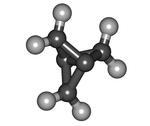| Revision as of 03:15, 23 January 2012 editWhoop whoop pull up (talk | contribs)Extended confirmed users35,195 editsmNo edit summary← Previous edit | Revision as of 14:23, 18 June 2013 edit undoNitrobutane (talk | contribs)333 editsNo edit summaryNext edit → | ||
| Line 35: | Line 35: | ||
| '''Propellane''' is an ], the simplest member of the ] family. It is a ] with formula C<sub>5</sub>H<sub>6</sub> or C<sub>2</sub>(=CH<sub>2</sub>)<sub>3</sub>. The molecular structure consists of three rings of three ] atoms each, sharing one C-C bond. | '''Propellane''' is an ], the simplest member of the ] family. It is a ] with formula C<sub>5</sub>H<sub>6</sub> or C<sub>2</sub>(=CH<sub>2</sub>)<sub>3</sub>. The molecular structure consists of three rings of three ] atoms each, sharing one C-C bond. | ||
| Propellane is a highly strained molecule. The bonds of the two central carbon atoms have an ], and the ] is 160 pm.<!--SO? WHAT IS A "NORMAL" VALUE?--> The ] is disputed; estimates vary from 59–65 kcal/mol to no strength at all. The energy of the ] state (without the central bond and unfilled central carbons) is calculated to be 80 kcal/mol higher. The compound is highly unstable, and at 114 °C it will spontaneously ] to ] with a ] of 5 minutes. Its ] is estimated to be 102 ]/] (427 ]/mol). | Propellane is a highly strained molecule. The bonds of the two central carbon atoms have an ], and the ] is 160 pm.<!--SO? WHAT IS A "NORMAL" VALUE?--> The ] is disputed; estimates vary from 59–65 kcal/mol to no strength at all. The energy of the ] state (without the central bond and unfilled central carbons) is calculated to be 80 kcal/mol higher. The compound is highly unstable, and at 114 °C it will spontaneously ] to ] with a ] of 5 minutes. Its ] is estimated to be 102 ]/] (427 ]/mol). | ||
| The type of bonding in this molecule has been explained in terms of ]ing <ref> | The type of bonding in this molecule has been explained in terms of ]ing <ref> | ||
Revision as of 14:23, 18 June 2013
The correct title of this article is Propellane. The substitution or omission of any brackets is due to technical restrictions.
| |||
| Names | |||
|---|---|---|---|
| IUPAC name Tricyclopentane | |||
| Identifiers | |||
| CAS Number | |||
| 3D model (JSmol) | |||
| ChemSpider | |||
| CompTox Dashboard (EPA) | |||
InChI
| |||
SMILES
| |||
| Properties | |||
| Chemical formula | C5H6 | ||
| Molar mass | 66.103 g·mol | ||
| Except where otherwise noted, data are given for materials in their standard state (at 25 °C , 100 kPa).
| |||
Propellane is an organic compound, the simplest member of the propellane family. It is a hydrocarbon with formula C5H6 or C2(=CH2)3. The molecular structure consists of three rings of three carbon atoms each, sharing one C-C bond.
Propellane is a highly strained molecule. The bonds of the two central carbon atoms have an inverted tetrahedral geometry, and the length of the central bond is 160 pm. The strength of that bond is disputed; estimates vary from 59–65 kcal/mol to no strength at all. The energy of the biradical state (without the central bond and unfilled central carbons) is calculated to be 80 kcal/mol higher. The compound is highly unstable, and at 114 °C it will spontaneously isomerize to 3-methylenecyclobutene with a half-life of 5 minutes. Its strain energy is estimated to be 102 kcal/mol (427 kJ/mol).
The type of bonding in this molecule has been explained in terms of charge-shift bonding
Synthesis
Propellane was first synthesized by K. Wiberg and F. Walker in 1982,. according to the following schema:
Sythesis begins with conversion of the 1,3-di-carboxylic acid of bicyclopentane 1 in a Hunsdiecker reaction to the corresponding dibromide 2 followed by a coupling reaction with n-butyllithium. The final product 3 was isolated by column chromatography at -30°C (!)
However, a much simplified synthesis was published by. It starts with dibromocarbene addition to the alkene bond of 3-chloro-2-(chloromethyl)propene 6 followed by deprotonation by methyllithium and nucleophilic displacements in 7 not isolated but kept in solution at −196 °C.
Reactions
Acetic acid addition
Propellane spontaneously reacts with acetic acid to yield a methylenecyclobutane ester (4 above).
Polymerization
propellane undergoes a polymerization reaction where the central C-C bond is split and connected to adjacent monomer units, resulting the so-called staffanes.
A radical polymerization initiated by methyl formate and benzoyl peroxide results in a distribution of oligomers. An anionic addition polymerization with n-butyllithium results in a fully polymerized product. X-ray diffraction of the polymer shows that the connecting C-C bonds have bond lengths of only 148 pm
The compound 1,3-dehydroadamantane, which can be viewed as a bridged Propellane, also polymerizes in a similar way.
See also
References
- Wei Wu, Junjing Gu , Jinshuai Song , Sason Shaik , Philippe C. Hiberty (2009), The Inverted Bond in Propellane is a Charge-Shift Bond. Angew. Chem. Int. Ed. volume 48, 1407–1410, doi:10.1002/anie.200804965
- K. B. Wiberg, F H. Walker (1982), Propellane. J. Am. Chem. Soc. volume 104 issue 19, pp. 5239–5240; doi:10.1021/ja00383a046
- J. Belzner, U. Bunz, A. D. Schlüter, G. Szeimies et al. "Concerning the synthesis of Propellane" Chem. Ber. volume 122, pp.397-398
- (1998) Organic Syntheses, Coll. Vol. 10, p. 658 (2004); Vol. 75, p.98 Online article.
- Piotr Kaszynski and Josef Michl (1988), Staffanes: a molecular-size "Tinkertoy" construction set for nanotechnology. Preparation of end-functionalized telomers and a polymer of propellane J. Am. Chem. Soc.; volume 110 issus 15, pp. 5225 - 5226; doi:10.1021/ja00223a070



